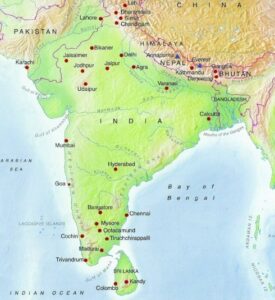How do the Deccan Traps provide information about Earth’s past and what geological processes resulted in their formation?
Model Answer Introduction Geographical factors encompass the physical features, climate, and natural resources of a region, significantly influencing the lifestyle, culture, and economic development of its inhabitants. In ancient India, these geographical attributes were pivotal in shaping the evoluRead more
Model Answer
Introduction
Geographical factors encompass the physical features, climate, and natural resources of a region, significantly influencing the lifestyle, culture, and economic development of its inhabitants. In ancient India, these geographical attributes were pivotal in shaping the evolution of civilization.
Understanding the Geographical Landscape of Ancient India
Physical Features
- Mountains: The Himalayan range acted as a natural barrier, protecting the Indian subcontinent from invasions while influencing regional climates (Singh, 2002).
- Rivers: The Ganges, Indus, and Brahmaputra rivers created fertile valleys that sustained ancient civilizations. These rivers not only enriched the soil but also facilitated trade and transportation (Basham, 1954).
- Plains: The Indo-Gangetic plains, formed from river deposits, supported agrarian societies due to their alluvial soil, ideal for diverse crops (Chakrabarti, 1999).
- Deserts: The Thar Desert influenced trade routes and shaped the lifestyle of its inhabitants, leading to caravan trade practices (Ghosh, 2013).
Climate
- Monsoons: The Indian monsoon was crucial for agriculture, dictating sowing and harvesting seasons, and fostering a deep-rooted agricultural calendar (Shukla, 2016).
- Temperature Variations: The diverse climates, ranging from cold Himalayas to the hot Thar Desert, influenced agricultural practices and dietary habits across regions (Rao, 2009).
Role of Geographical Factors in Development of Ancient India
Economic Development
- Agriculture: Fertile lands along the Indus and Ganges supported surplus production, crucial for trade. Neolithic sites near river basins in Jammu and Kashmir exemplify this (Possehl, 1998).
- Trade and Commerce: Coastal regions facilitated maritime trade with civilizations like Mesopotamia, establishing significant ports like Lothal (Rao, 2000).
Sociopolitical Development
- Formation of Kingdoms: Regions rich in natural resources contributed to the rise of powerful states like the Maurya and Gupta empires (Thapar, 2002).
- Urbanization: Strategic cities near rivers, such as Mohenjo-Daro, became hubs for trade and agriculture (Allchin, 1995).
Cultural Development
- Religion and Philosophy: The serene environment fostered philosophical thought, giving rise to religions like Hinduism and Buddhism (Eck, 2012).
- Art and Architecture: Abundant natural resources influenced artistic expressions, leading to the creation of monumental structures and sculptures (Mehta, 2008).
Conclusion
Geographical factors were instrumental in crafting the cultural, economic, and political landscape of ancient India. The interplay of physical features and climate not only shaped daily life but also catalyzed a rich tapestry of cultural developments, establishing one of the world’s oldest civilizations.
See less

The Deccan Traps were formed through extensive volcanic activity that occurred around 66 million years ago during the late Cretaceous period. This geological phenomenon was driven by a mantle plume, which caused massive outpourings of basaltic lava over a relatively short geological timespan. The reRead more
The Deccan Traps were formed through extensive volcanic activity that occurred around 66 million years ago during the late Cretaceous period. This geological phenomenon was driven by a mantle plume, which caused massive outpourings of basaltic lava over a relatively short geological timespan. The resulting lava flows covered large areas, creating one of the largest volcanic features on Earth. These basaltic layers, known as traps due to their step-like formations, provide critical insights into Earth’s history. They offer evidence of volcanic activity’s role in shaping the planet’s surface and contributing to mass extinction events, including the one that led to the demise of the dinosaurs. The Deccan Traps also help scientists understand the processes of plate tectonics, mantle dynamics, and the long-term impact of volcanic activity on climate change, as the released gases could have caused significant atmospheric alterations.
See less